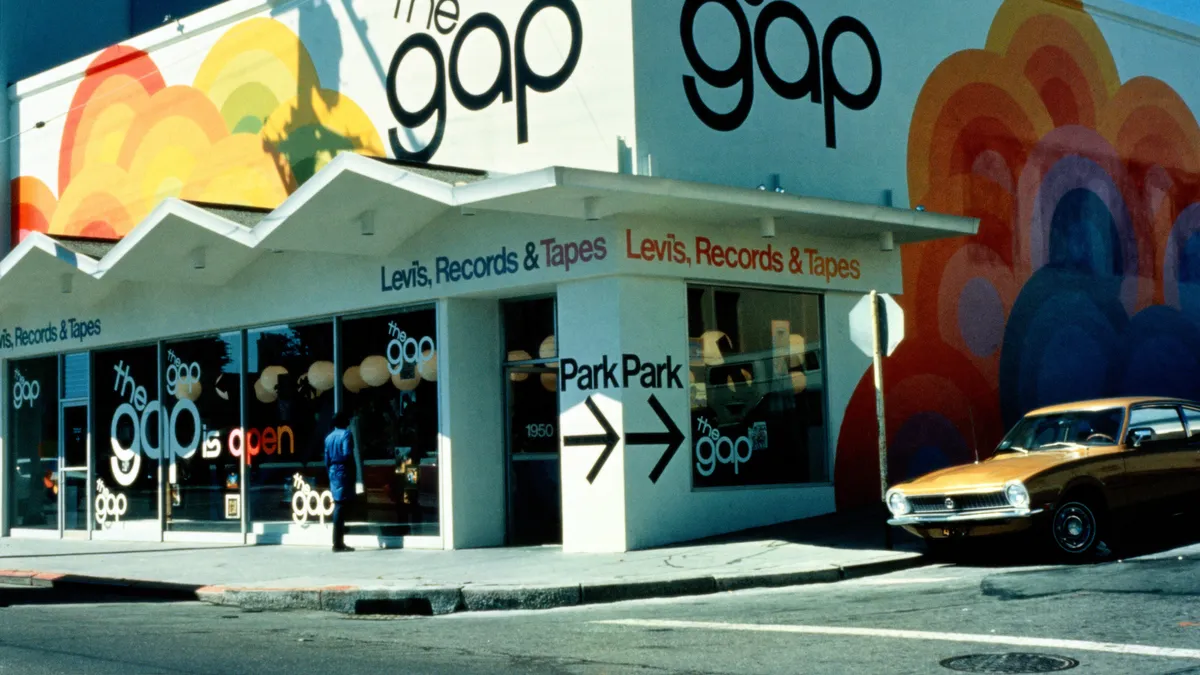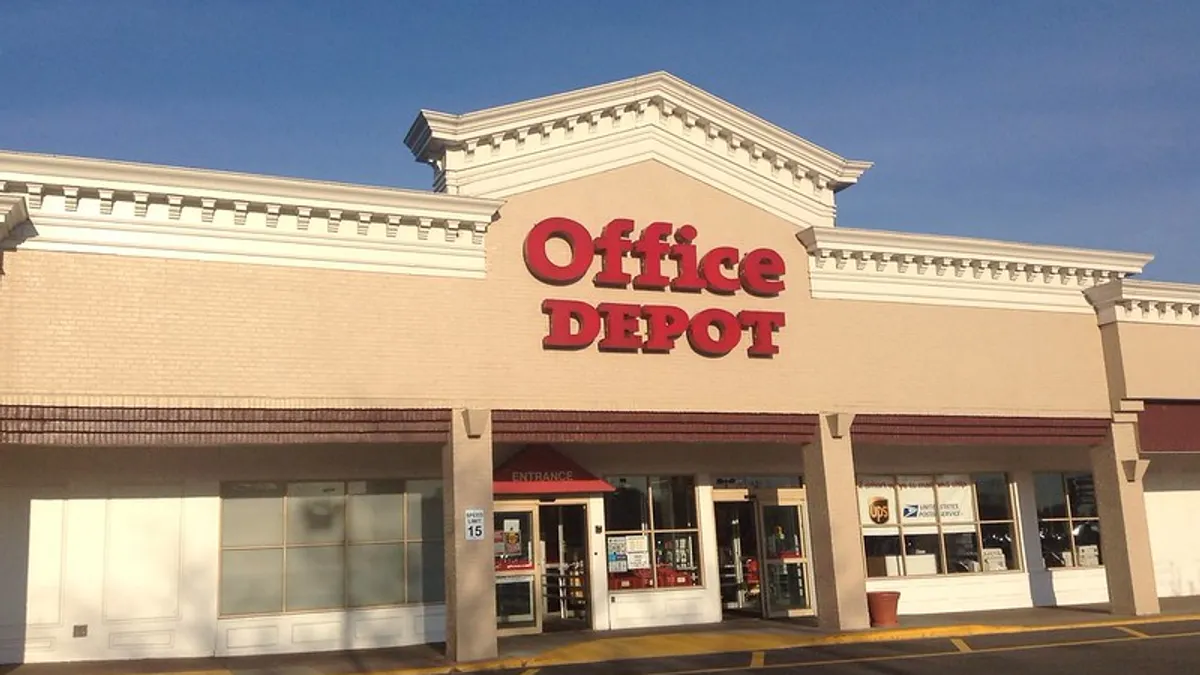Since the abrupt departure of Art Peck in late 2019, Gap Inc. has had more interim CEOs than permanent ones, as well as turnover in leadership at all of its four brands — namesake Gap, Old Navy, Banana Republic and Athleta. Next week, yet another new chief executive arrives.
It's not clear whether Richard Dickson, fresh from a successful reboot of the Barbie brand but with little experience in apparel, will be the one to finally turn the ailing San Francisco-based conglomerate around. While he has been on Gap Inc.’s board for several months and led Jones Apparel Group’s branded businesses for four years, he has spent most of his career at toy maker Mattel, ending up as its operations chief until this month.
“I know a lot of people have been pooh-poohing that or scratching their heads about that. But I think it's actually not a bad idea to step out of the box and get somebody who's taken a banner brand and brought it back to life in a fun and relevant way, which is what happened with Barbie,” Lee Peterson, executive vice president of thought leadership and marketing at WD Partners, said by phone. “He can do that, potentially, with Gap’s brand. But somebody has to make the merchandise that goes along with that.”
Dickson’s apparel experience may not be extensive, but his approach to innovation and customer focus is what Gap Inc. needs, according to Liza Amlani, principal and co-founder of Retail Strategy Group.
“I really love the way that he talks about overseeing things like wholesale and retail and e-commerce and omni, and about innovation and the customer,” she said by phone. “That's where fashion can be so fickle — if you don't know what your customer is looking for, why they come to you in the first place. He can really bring a strategic perspective with his own playbook, through all of the experiences he's had, including Mattel. And this is where I get excited because I think that the voice of the consumer has been missing from Gap Inc. for years.”
Moreover, there’s more overlap between toys and apparel than many may realize, according to BMO Capital Markets Managing Director Simeon Siegel. Both are very much discretionary purchases, with seasonal ups and downs, that require a sophisticated level of marketing, he said by phone.
“Toys and apparel share more similarities than might be apparent at face value."

Simeon Siegel
Managing Director, BMO Capital Markets
“Both need a compelling product, but, just as much, they need a compelling story,” he said. “So toys and apparel share more similarities than might be apparent at face value. For the Mattel business, the toy business, knowing the brand, and protecting the brand, has been critical. So there could very well be an easy baton pass within those two sectors.”
Some in the industry cheered the fact that Dickson has operational strength at a place like Mattel, rather than apparel merchandising chops.
“I am thrilled they didn't pick a garmento,” Jeffrey Sward, founding partner and CEO at Merchandising Metrics, said by email. “Gap was at its best with pretty straightforward product and brilliant marketing. If they can energize both product and marketing, they can be a force again. It's not the CEO's job to be the chief merchant for every single business. It is his job to create a business model that demands both great storytelling and profitability.”
Still, the pressure is on Dickson, and entrusting him with Gap Inc.’s turnaround will take something of a leap of faith, according to Mark Cohen, director of retail studies at Columbia University’s Graduate School of Business and a veteran of the company. Gap Inc. and each of its brands require “fundamental re-positioning” and new strategies around product, design, sourcing, pricing and presentation, Cohen said by email.
“There’s absolutely no good reason why this company has foundered but for a really egregious lack of good leadership, and if he can provide that and build powerful teams behind these iconic brands (particularly Gap) he might pull this off,” he said.
Here’s what awaits Richard Dickson at each of the company’s four brands.
Old Navy
Gap Inc.’s discount label, founded in 1994 and the first in the stable to reach $1 billion in sales, quickly became the company’s powerhouse. Among single-brand specialty retailers, Old Navy, whose sales reached $8.2 billion last year, is the second-largest apparel seller in North America, behind Nike, according to BMO’s Siegel.
"Old Navy is able to sell a tremendous amount of lower-price product with their name stamped all over it. That’s skill.”

Simeon Siegel
Managing Director, BMO Capital Markets
“I mean it just is a colossal business that defies any of the odds for mono-brand, specialty apparel,” he said. “And they've created a brand for lower price points, which is hard to do because it is hard to broadcast being inexpensive. They overcame the stigma. Old Navy is able to sell a tremendous amount of lower-price product with their name stamped all over it. That’s skill.”
But Old Navy has been in turmoil in recent years, with leadership turnover and growth receding at times. From a merchandising perspective, there is too much product and no real identity, according to Amlani.
It may also be time to ask whether it has peaked, Siegel said.
“It's probably worth determining whether there actually is room for domestic growth or whether this is the time to focus on driving margin and generating cash,” he said. “Because the business is so large but it is still a brand, and brands reach saturation points.”
Banana Republic
A few years ago, amid falling sales and the rise of more casual workwear, many had written Banana Republic off. But the brand still does a brisk business, and has recently shown signs of new life thanks to merchandising and marketing revamps.
“Banana Republic by all accounts as a standalone would be one of the largest apparel brands around. But because it's grouped in with the rest of the Gap Inc. entity it's often ignored,” Siegel said, though he noted that the company doesn’t break out profitability for any of its brands.
Still, the brand’s clothing and marketing campaigns have broken out from the “boring middle,” something its sibling Gap must also do, according to Sward. “I loved what they were doing a year ago,” he said. “I think recently they got a little too sophisticated and the numbers show that.”
Banana Republic is mostly a menswear brand, whose women’s offer needs attention, Amlani said, adding that its forays into baby apparel and home goods have been unhelpful distractions.
Athleta
With Old Navy ebbing somewhat, Banana Republic in the middle of a turnaround and namesake Gap perennially struggling, Gap Inc. in recent years pinned its hopes for growth on its Athleta activewear label. Last year, the company maintained its target of $2 billion in annual sales for Athleta, with some analysts contemplating a spinoff. But in its most recent quarter, Athleta net sales fell 11% to $321 million, with comps down 13%.
Disappointment has set in, and the brand got another new CEO, Alo Yoga’s Chris Blakeslee, the same week Dickson’s appointment was announced. But, as with the strengths at Old Navy and Banana Republic, the accomplishments at Athleta are too easily dismissed, according to BMO’s Siegel.
“Athleta was pitched as being the savior, and that was probably bad for its narrative, because it did just under a billion dollars pre-COVID, and now it’s at 1.5,” he said. “To be fair, the business has stalled, it's going down, so they do need to work that through. But how we judge retailers may dictate their perceptions of success much more so than what they actually put up. All things considered, it’s a very nice business at a billion-and-a-half dollars.”
Comparing Athleta to Lululemon or DTC brands like Alo Yoga is unfair because the brand offers a wider set of price points and sizes, to appeal to a wider audience, financial and merchandising analysts say. In fact, Athleta itself may be doing too much of that, according to Amlani.
“Athleta is not innovative at all,” she said by phone. “I would say they're almost too satisfied to get inspiration from Lululemon or from what Nike is doing. There's nothing really new happening at Athleta. So bringing in someone for Athleta, and then the entire Gap Inc. organization — I think this is where we're gonna really start to see what does each banner stand for.”
Gap
The company’s namesake brand also has strengths, though most are in the past.
When it launched in 1969, Gap started out as single store in San Francisco, selling Levi’s and other goods in fits and styles not found at department stores. Eventually it morphed into its own label of mostly basics — jeans, khakis, T-shirts, sweaters and sweats — whose vibe depended on a series of brilliant marketing campaigns and successful collaborations.
With one notable exception — a disastrous partnership with Ye, also known as Kanye West, for "Yeezy Gap" — the brand continues to hit the mark with some of its collaborations, according to experts. That includes a partnership with Dapper Dan that had people coveting its sweatshirts again and, more recently, with LoveShackFancy.
Gap’s marketing no longer resonates, though, a steep fall for a brand that once confidently enlisted icons like Miles Davis, Marilyn Monroe and Louis Prima, and celebrities from all spheres of life, for its campaigns. Several analysts said that merchandising failures, quality declines and a penchant for markdowns at Gap also show that it has lost sight of who its customer is.
“Gap the brand has been on a revenue decline for more than a decade, probably close to two, and Gap has been playing defense for a very long time,” Siegel said, noting that promotions and inferior quality are often attempts to rescue the topline and protect margins, but risk brand quality.
“At the end of the day, both of those are examples of forcing revenue,” he said. “And both of those are instances of trying to salvage today at the cost of tomorrow.”
Overall, the brand has lost its mojo, experts said, which may be a different project for Dickson compared to his time at Mattel. Longtime Gap Inc. executive Mark Breitbard has overseen the brand for the past three years.
“It’s GOT to get a better merchandising mix. Every attempt they’ve made at improving it has been worse than the one before, and the original looks are now available for way less money at Target,” Paula Rosenblum, co-founder and managing partner at RSR Research, said by email. “I truly don’t know what Gap stands for. Barbie, we knew.”























